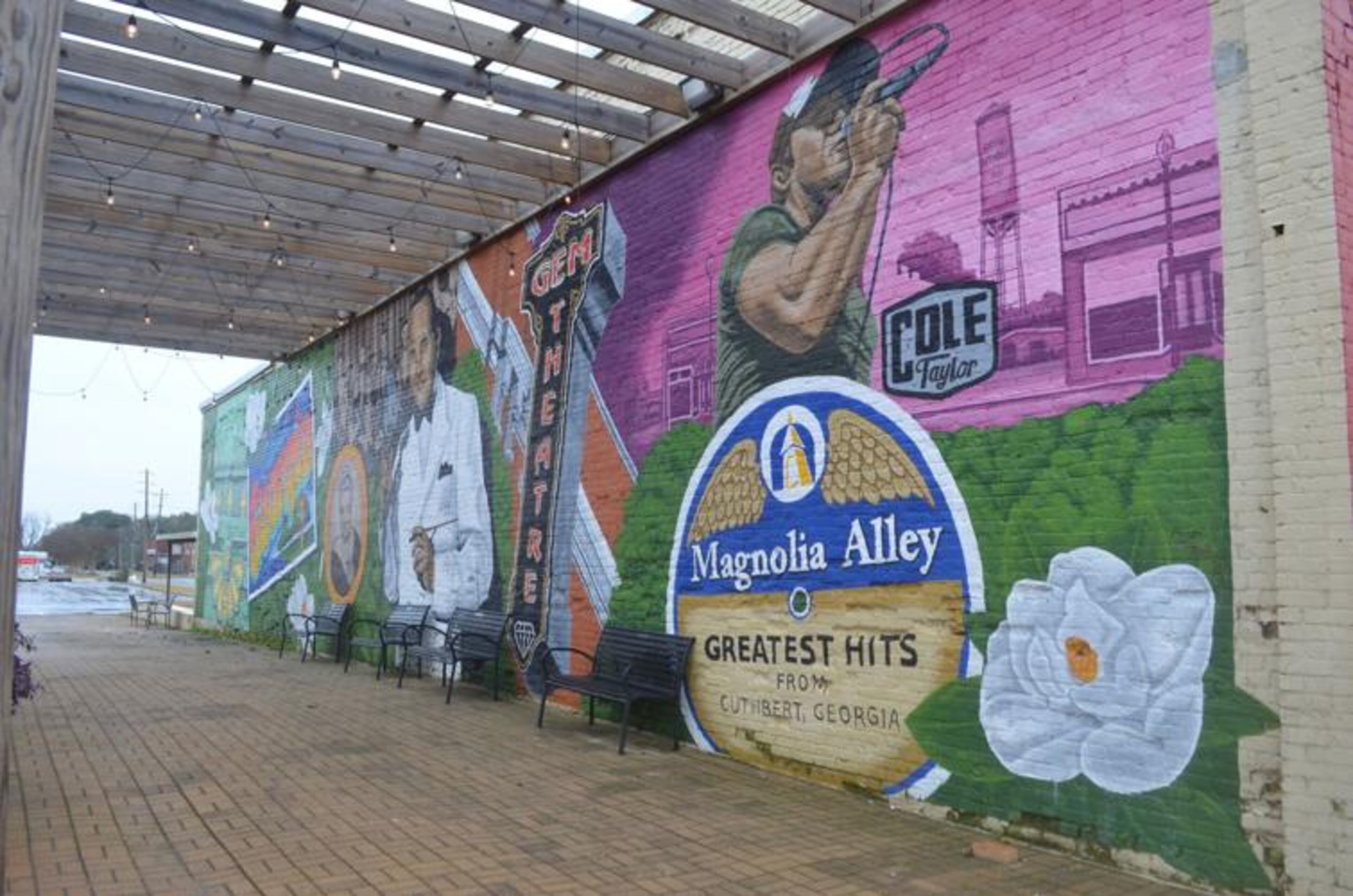Southwest Georgia murals push to revitalize and instill civic pride

Southwest Georgia stories exist on the sides of crumbling brick buildings in small towns that time is at risk of forgetting.
Colorful, historic scenes of agriculture, industry and celebrated community members are painted on murals throughout the region’s historic districts. Colquitt, Cuthbert, Shellman, Dawson, Americus, Albany and more, all with unique stories to tell.
Public art can be a useful tool for economic development at a local level as it drives tourism, according to Americans for the Arts, a nonprofit that advances the arts. Many southwest Georgia towns use them in efforts to grow and hold onto their identities.

The small city of Colquitt’s Millennium Murals may be one of the earliest examples. The project began in 1999 and captures local folk life stories and the town’s critically acclaimed Swamp Gravy theatrical productions.
Visitors can’t miss the 16 murals that line downtown buildings or tower over the community on two large silos. They instill a small-town pride, Will Murdock, the Colquitt-Miller Arts Council’s artistic director, said.
“I know a lot of towns have murals, but the murals here each tell a story from the town,” he said. “It’s unique to Colquitt.”
More and more such works of art are popping up throughout southwest Georgia as cities try to draw tourists. The Albany Museum of Art’s Teen Art Board plans to implement a large mural in Albany’s downtown by hosting a community paint day for school-aged youths in the spring.
The Teen Art Board, made up of 14 high school students from area schools, are using the mural as a tool for downtown revitalization. The students want to destigmatize and revitalize Albany’s downtown, Annie Vanoteghem, AMA’s education director, said.
“They feel that people are scared to go downtown, and if you want something to grow and be better, you need to show up and work on it,” she said. “Don’t be scared of it.”
The art board is in communication with a private business owner along Front Street about using a wall for the project. The students are trying to raise $10,000 to have Ramiro Davaro-Comas, a muralist and artist whose series “Familias” was recently displayed in the AMA, to come and host the paint day. The AMA hopes to hire Davaro-Comas to do more murals throughout the Albany community, Vanoteghem said.
Vanoteghem said she sees endless opportunities for murals throughout Albany. This public art stays within community minds, she added.

Many of the murals that have popped up around southwest Georgia in recent years are the work of Chris Johnson, a Columbus-based artist and muralist. In 2016, he was working as the sole art professor at Andrew College in Cuthbert, when the Cuthbert Chamber of Commerce commissioned him to do murals downtown through vibrant communities grants.
“Cuthbert was a really rundown downtown,” Johnson said. “Businesses left. Shells of buildings were everywhere. When you’ve got a dusty, rusty crumbling downtown, something bright and pretty … distracts from all the dusty and rusty.”
Community perceptions changed once the city began filling the small downtown with murals, the artist said. Citizens felt like they were finally seeing good in the city, and local businesses started filling the vacant spaces.
Murals are a relatively inexpensive way for cities to liven up their downtowns and inspire people to see the potential in them, he said.
Johnson’s work snowballed as more rural towns wanted to bring a mural to their community. He’s traveled all around Georgia, Alabama, North Carolina and South Carolina to complete murals. However, southwest Georgia is his sweet spot, he said.
“Mainly because it’s kind of this land that time forgot,” Johnson said. “There’s a need for civic pride.”
The type of work he does differs in each community. Some cities want to honor their history, he noted.
“There is this mythological legacy about these towns that they used to be so great — and a lot of them really were,” Johnson said. “They had this industry … agriculture … transportation with the railroads. And they want to harken back to that to kind of commemorate the golden age.”
This is seen on the grain bins in Shellman. Six tall bins depict the past, present and future of the community, emphasizing agriculture.
Courtney Ferguson, a Shellman resident, said the murals showcase rural America and what it’s like to live in the South.
“I think that meant a lot for people,” she said.
The grain bins were a huge conversation topic as Johnson worked on them. The community watched through storefront windows as its story was unmasked on the grain bins. It created excitement, Ferguson said.
The murals put Shellman on the map, she said. Now, people come into town specifically to take photos of the art pieces.
“It was a big thing for Shellman because we’re so tiny and so secluded,” Ferguson said.
Johnson’s murals in Dawson create nostalgia and make community members feel seen, Shawn O’Connor-VZ, the downtown development authority executive director said. Dawson was no stranger to murals. Old, faded scenes line the downtown, showcase historic scenes and highlight different community members.
When an old mural began to fade on the Terrell County Chamber of Commerce building, the chamber board got permission from the artist to cover it with a new one. The new piece, which says “welcome to Dawson,” commemorates the city’s history with depictions of Otis Redding, who was born in Terrell County, as well as homages to agriculture, quail hunting and Dawson’s historic downtown.
Redding is central to the piece, which meant a lot to community members, O’Connor-VZ said.
“It was a real healing effect for our community because for many years, there have been … people in the community, feeling like their history was overlooked,” he said. “People in the community, who have often been overlooked or disenfranchised, really felt like they suddenly were being honored and had a seat at the table.”
There was an outpouring of people at the ribbon-cutting for the artwork, and it seemed to spur the dawn of a new era, the executive director said.
“It’s unbelievable how many people stop and take pictures and how much it means to the community,” he said.
The desire to shed tradition and move toward the future is another pattern Johnson sees in requests for murals. Some clients ask him to simply fill spaces with unique pieces that are eye-catching or conversation starters.
The large butterflies painted on the wall of Bottoms Up Wine & Spirits on Westover Boulevard in Albany is a popular site for photos. The colorful flying insects look like they’re fluttering along the wall. “Small things” is written in the bottom corner. It’s easily visible from the road.
Johnson is currently sketching a design for Phoebe Putney Memorial Hospital’s new living and learning community in the former Albany High and Middle School on Jefferson Street. Johnson will begin working on it in the spring, he said.
The muralist said he believes public art is powerful within communities and sparks enormous change and pride.
“Everywhere I look in every community, I see opportunities for growth in one way or another,” Johnson said.

MEET OUR PARTNER
Today’s story comes from our partner, The Albany Herald. The Albany Herald publishes daily in print and online at albanyherald.com, providing coverage of community news, events, and sports in Southwest Georgia.
If you have any feedback or questions about our partnerships, you can contact Senior Manager of Partnerships Nicole Williams via email at nicole.williams@ajc.com.
